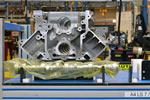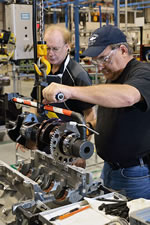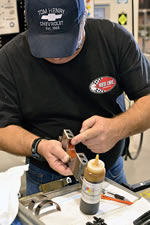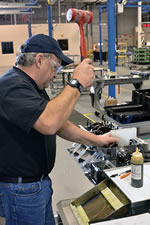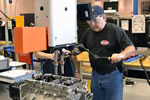Is this a Dream or is that really my LS7? Page 3 of 10
Is this a Dream or is that really my LS7?
CAC Does the Corvette Engine Building Experience - Page 3 of 10
by Hib Halverson
© September 2012
No use without permission, All Rights Reserved
Then, we moved onto the production floor and, at the first engine assembly station, there was an LS7 bare block (PN 12598723) and a camshaft were sitting in a rack on one of the benches, but this wasn't just any bare block. It was job #09719-my block. Stickers, printed with the job number and a bar code, also, had my name on them and would eventually be applied to both ends of the left head. Is cool or what? We bolted that block to the rolling engine stand and we were ready to begin putting my motor together. I was pumped. Ya think?
Ok. I admit it. Some of my engine building ideas are oldskool, such as-before you assemble anything, you scrubbed bare blocks with hot water and Tide until you were blue-in-the-face, so I was amazed to learn there is no pre-assembly parts cleaning at the Performance Build Center. Linamar, which does the block and head machine work and subassembly, and other suppliers are required to furnish parts which are clean and ready for assembly. I asked Rob Nichols how they ensure suppliers meet that goal. "We visually check all parts and if they are not to our liking, we send them back. Periodically, we test wash blocks and crankshafts. Any contaminants fall into a filter we place at the bottom of a wash basin," Nichols told the CAC. "The weight of these filters is pre-measured. We take the filters and sediment and bake them in an oven to dry out the filter and debris. Then, we reweigh the combination. The difference between the base weight and the weight of the filter with debris gives us the amount of sediment washed off of the parts. We have tolerances for the amount allowed. If it falls out of spec, we alert the supplier and (do further testing to) make sure all incoming product is conforming."
First, I installed the camshaft. Then, we mounted the block on a rolling cart. Mike and I removed the main cap bolts then, since the caps are a snug fit in the deep-skirted block, Mike gave me a special "puller" to remove the caps. Next, I installed the upper main bearing shells and smeared some assembly lube on them.
Another of the LS7 engine parts which I think is so pretty is the crankshaft. With its interesting brownish-coppery color and intricate finish machining-darn it-it's just too cool-looking to be in an engine. Heck, it oughta be the support for a glass-top end table next to my couch. The eye candy that they are, LS7 cranks are pretty trick parts for a production application being micro-alloy steel forgings manufactured by specialty supplier, SMI Crankshaft.
In my own shop, I'd lift cranks up off the floor and set them carefully in the main bearings. At the Performance Build Center, because safety is an overriding concern, most heavy parts are lifted and moved with power hoists. After using one to place the crank in the block, I told Mike, "Man, I could get used to that. I need one of them in my shop."
Once the crank and the main caps where in with two bolts hand tight in each cap, Mike hands me a two-pound, dead-blow hammer with a 24-inch handle. I was to take it and a block of Delrin and whack the top of each cap in order to seat it in the block. I looked at him thinking: I paid a boat load for my new car and you expect me to beat on my LS7 with this BFH? "Well, alrighty then," I said aloud and, after getting a good grip on the hammer-BAM-I smacked #1 main cap. I did that five times-once for each cap. It never did feel comfortable.
Next, I had my first experience with some of the seriously big power tools used at the PBC. Made by Atlas Copco, USA and called "spindle multiples," they tighten a group of fasteners all at once. One of these spindle multiples is used on the vertical bolts of each main bearing cap. They are tightened two at a time simultaneously, first the inners then, after an adjustment to the machine, the outers. Each spindle tightens its bolt to just the right torque angle after which the machine's indicator lights tell the operator if the bolts are properly tightened. Finally, the machine sends tightening data to the PBC's central computer. One reason for these power tools is their accuracy in tightening bolts. Also, by tightening the cap bolts by pairs and in one movement, strain is applied to block's main webs evenly rather than one side at a time and in increments. After all 20 vertical bolts are tight, the 10 horizontal bolts are tightened using a hand-held, power-driven wrench. The computer is always following-up for the assembler making sure he/she doesn't miss a bolt or nut.
